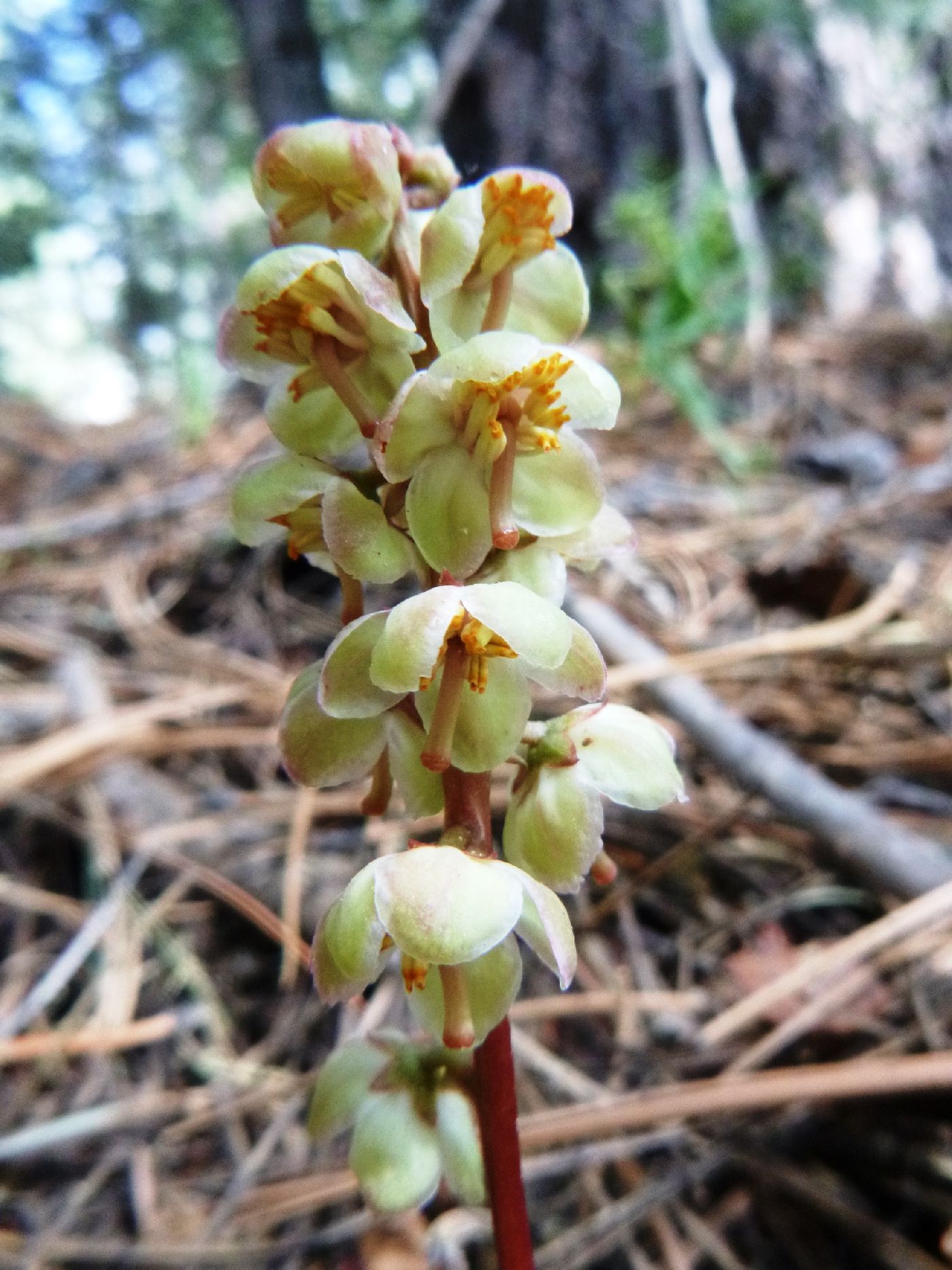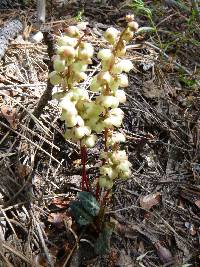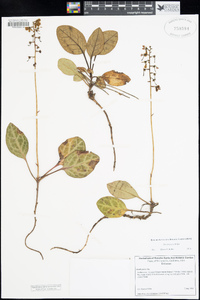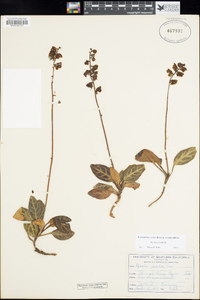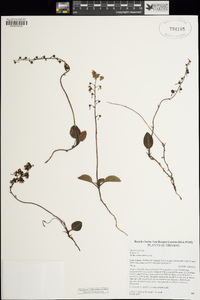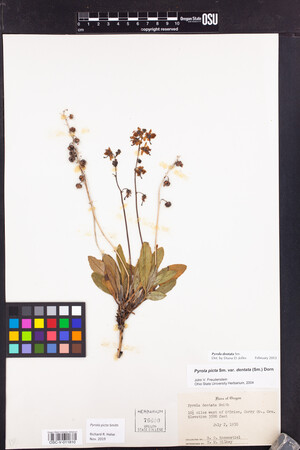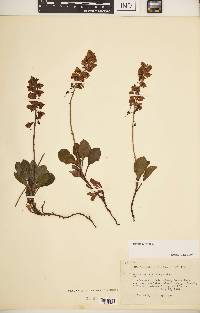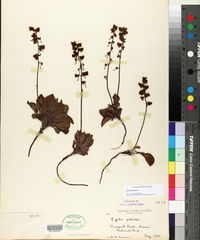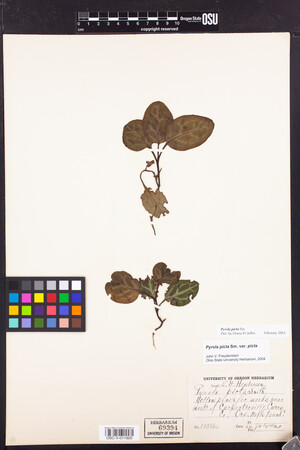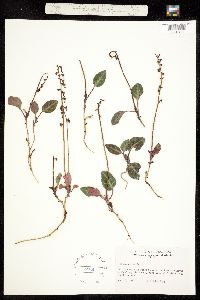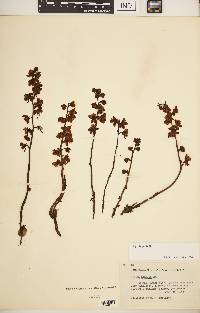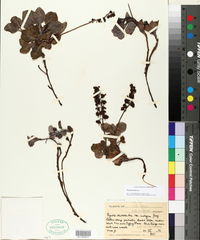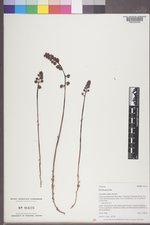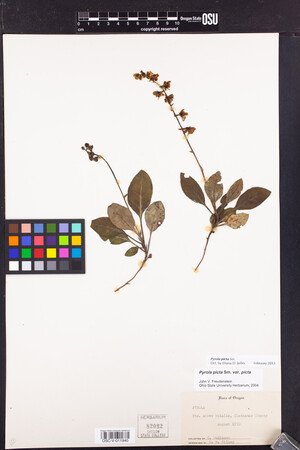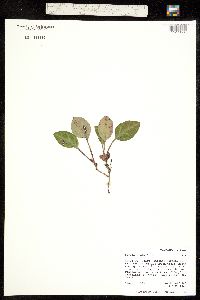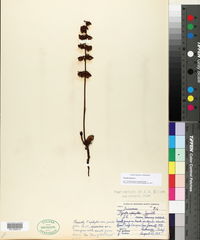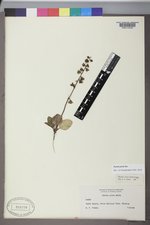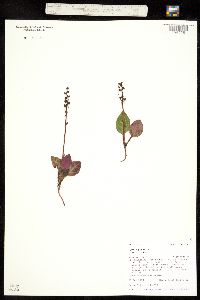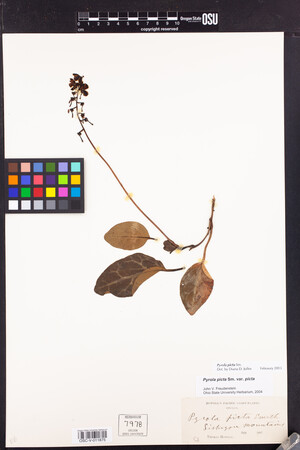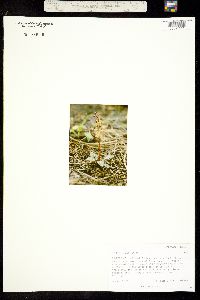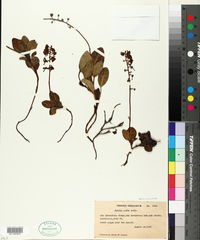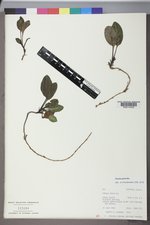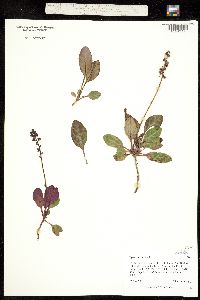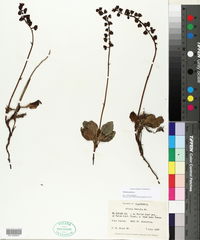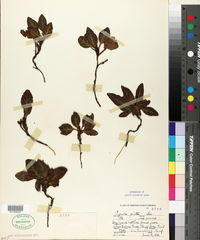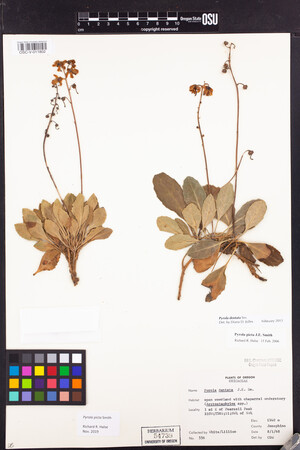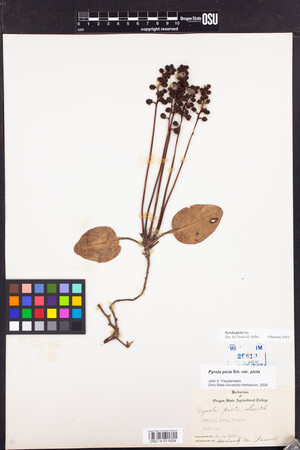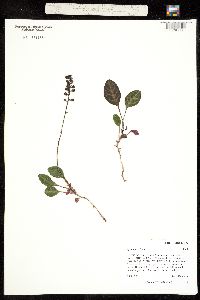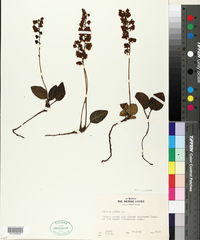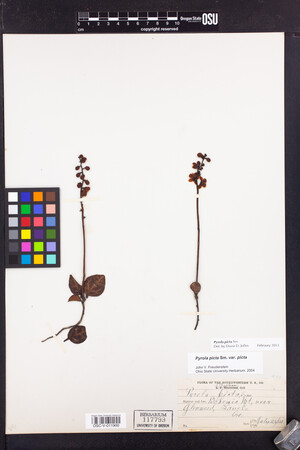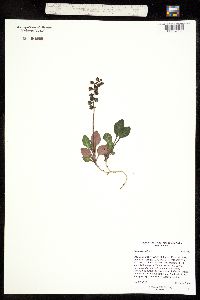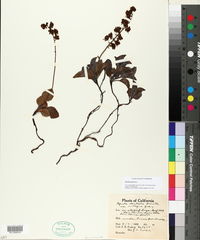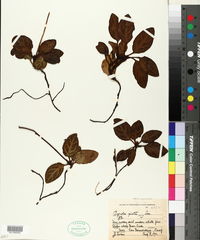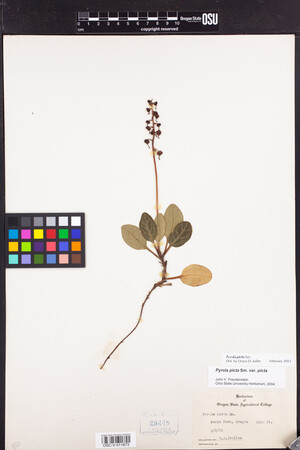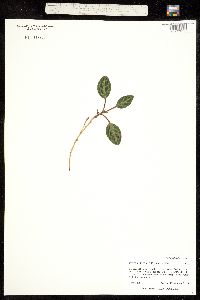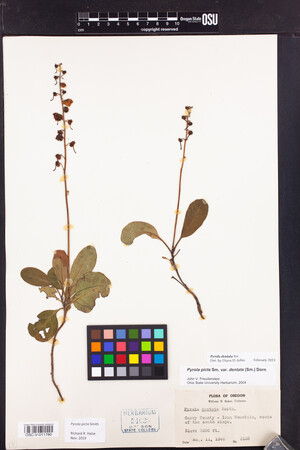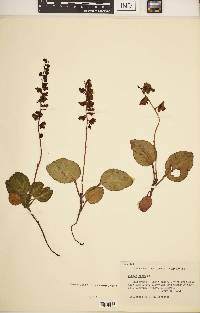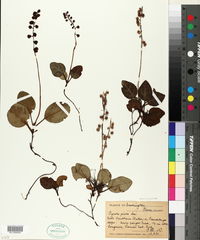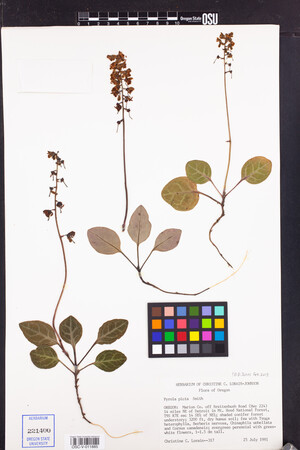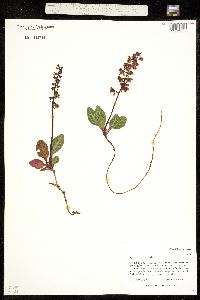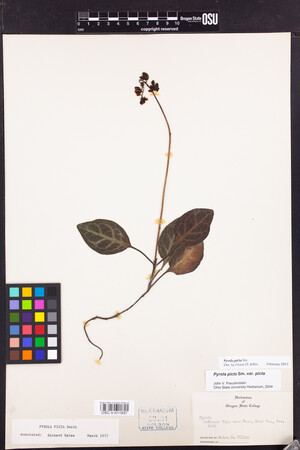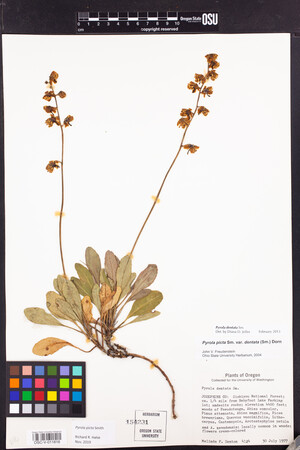Pyrola picta
|
|
|
|
Family: Ericaceae
White-Vein Wintergreen, more...whiteveined wintergreen, whitevein shinleaf
[Pyrola blanda Andres, morePyrola conardiana Andres, Pyrola pallida Greene, Pyrola paradoxa Andres, Pyrola picta subsp. dentata (Sm.) Piper, Pyrola picta subsp. integra (A. Gray) Piper, Pyrola picta subsp. pallida Andres, Pyrola picta var. dentata (Sm.) Dorn, Pyrola picta var. integra (A. Gray) Piper, Pyrola picta var. pallida (Greene) Parish, Pyrola septentrionalis Andres, Pyrola sparsifolia Suksdorf] |
Plants rhizomatous, (0.5-)1.5-4.6 dm. Leaves sometimes highly reduced or absent; petiole 4-25 mm, channeled adaxially, glabrous; blade usually maculate, sometimes not maculate, dull and light green to purplish abaxially, dull or shiny and green to dark green, usually with white tissue bordering larger veins adaxially, ovate or ovate-elliptic to oblanceolate or spatulate, 8-80 × 4-49 mm, coriaceous, base obtuse to attenuate or decurrent, margins entire or denticulate to coarsely denticulate, apex obtuse to acute. Inflorescences 1-2(-3), 4-24-flowered; peduncular bracts 1-5, subulate to narrowly lanceolate, 3-9 × 1-2 mm, membranous, margins entire or erose-denticulate; inflorescence bracts subulate to ovate-lanceolate, usually shorter than or, rarely, longer than subtended pedicels, 3.5-6 × 2-3 mm, herbaceous. Pedicels 3-18 mm. Flowers: calyx lobes appressed or spreading in fruit, green with margins hyaline to white or pinkish, widely deltate to widely ovate, 1.1-3.9 × 1.1-2.4 mm, margins entire or erose-denticulate, apices acute; petals greenish white, white, pink, or reddish, obovate, 4.2-11.2 × 3.1-7.1 mm, margins entire or obscurely denticulate; stamens 5-9 mm; filament base 0.5-0.8 mm wide; anthers 1.8-5.5 mm, apiculations absent or 0.1-0.2 mm, thecae creamy white to pink, tubules orange, 0.4-0.8 mm, gradually narrowed from thecae, lateral walls usually touching for most of their lengths, pores 0.1-0.3 × 0.1-0.2 mm; ovary smooth; style exserted, 4-9 mm; stigma (0.8-) 1-1.6 mm wide, lobes erect. Capsules depressed-globose, 3-6 × 6-9 mm. 2n = 46. Flowering Jun-Aug. Dry, coniferous forests; 400-3000 m; Alta., B.C.; Ariz., Calif., Colo., Idaho, Mont., Nev., N.Mex., Oreg., S.Dak., Utah, Wash., Wyo. E. Haber (1987) concluded that Pyrola picta, P. aphylla, and P. dentata are morphotypes of a single, highly variable species, a finding consistent with seed morphology data compiled by Hiroshi Takahashi (1993). Leafless scapes frequently are found attached to rhizomes bearing leafy shoots (W. H. Camp 1940; Haber 1987). Putative hybrids between P. picta and P. chlorantha have been reported at three locations in the western United States (Haber 1993). Cladistic analyses of molecular and morphologic data suggest that P. picta is sister to P. chlorantha (J. V. Freudenstein 1999b), which also occasionally is leafless.
Plant: Perennial rhizomatous, scapose herb Leaves: blades ovate, elliptic, to oblanceolate, (0.8-)3.5-6.0 (-8.0) cm long, leathery, dark green above, commonly purple below; veins generally white-bordered; margins minutely crenately toothed or denticulate INFLORESCENCE: glabrous symmetric bracteate racemes Flowers: with sepals ovate, these (1.0-)1.5-3.0(-3.9) mm long, the tips acute; petals greenish, cream-white or pink, (5.0-)6.0-7.5(-8.9) mm long; anthers (2.5-)3.0-4.0(-4.5) mm long, the tubes prominent, the pores small Fruit: FRUITS 5-locular drooping capsules with a depressed center and fibers connecting opened valves Misc: Dry coniferous forest; 2400-2900 m (8000-9500 ft); Jul-Aug Notes: scapes (3-)15-25(-36) cm tall; bracts all ovate-lanceolate to subulate, shorter than pedicels REFERENCES: Haber, Erich. 1992. Pyrolaceae. Ariz.-Nev. Acad. Sci. 26(1)2. General: Perennial, evergreen, 6-30 cm tall; scapes erect; herbage glabrous; rhizomes long. Leaves: Basal, alternate, crowded, ovate, elliptic, or oblanceolate, 2.5-7.5 cm long, 1-6.5 cm wide, glabrous, leathery, dark green and mottled with white along the veins above, often tinged with red below, margins entire or minutely crenate to dentate, base and apex broadly rounded to somewhat acute; petiole 1-4.5 cm long. Flowers: Inflorescence a raceme, mostly 4-10 flowered, the flowers bilateral, nodding; pedicels 3-6 mm long; sepals 5, broadly ovate-triangular, 1-1.6 mm long; petals 5, 5-9 mm long, pale green, white or cream; stamens 10, the anthers juxtaposed on the upper side of the flower; style elongate, 4-7.5 mm long, curved, exserted from the corolla; flowers June-August. Fruits: Loculicidal capsule, 6-9 mm in diameter; seeds numerous, minute. Ecology: Coniferous forests; 2400-2900 m (8000-9500 ft); Apache, Coconino, and Graham counties; western Canada, western and southwestern U.S. Notes: This plant is easily recognizable by its variegated or mottled basal leaves. Editor: Springer et al. 2008 |

